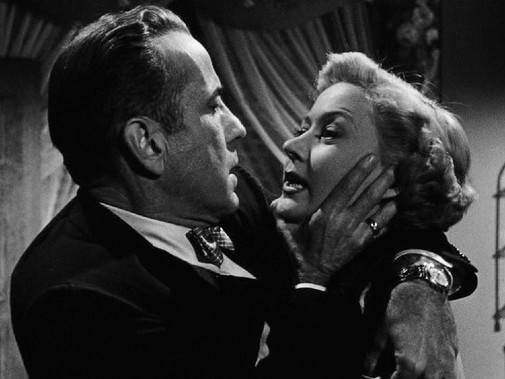
There's something deeply unsettling about finding yourself scared of someone you love. Part of it is the admittance of personal failure to oneself for the frightened person is the one that let themselves become vulnerable. To love is to let defenses fall and lay splayed at the mercy of another, believing our beloved will never abuse the gift of openness they have been given. We hope against hope that this trust is well-founded but sometimes it isn't. To realize you're scared may lead you to accept loneliness as a companion or else learn to live with fear. Like a toxic cocktail of arsenic and vinegar, that second option is a difficult thing to swallow and can be deadly. It often is.
Such nightmares of heartbreak and panic have rarely been better captured in celluloid than in Nicholas Ray's In a Lonely Place…

The movie is adapted from a Dorothy B. Hughes novel though it keeps very little of the original text. Ray and his screenwriters, Andrew Solt and Edmund H. North, molded an astringent study in societal and individual misogyny into a doomed romance. In that regard, they followed the example of their protagonist, a screenwriter by the name of Dix Steele whose adaptation of a Du Maurier-esque novel has very little to do with its source. On Hughes' book, Dix was a writer. More importantly, he was a killer whose guilt was a certainty to the reader rather than a paranoid possibility.
Dix's cinematic incarnation may be a violent lonesome figure, but his guilt is never established, despite being amply suggested by various characters. Following the barebones model of a noir, In a Lonely Place sees its screenwriter anti-hero become a suspect in the murder of a young woman who spent an evening in his company. Confronted with the suspicions of the police, he's apathetic, mocking even, the perfect embodiment of an aloof cad for whom life has little value. Luckily for him, there's a neighbor ready to testify on his behalf, putting a temporary stop to the unflood of suspicion. She is Laurel Gray, a beautiful blonde who likes Dix's face.
She's also Gloria Grahame, giving the best performance of her career, perhaps because the role hit close to home. When reimagining the novel, Nicholas Ray had turned Dix into an avatar for himself, philtering his frustrations with Tinseltown through the mouth of this embittered man. Appropriately, he cast his wife in the role of Dix's love interest and made the film into the autopsy of a doomed love affair rather than a simple murder mystery. Considering Grahame and Ray's marriage was already crumbling by that time (it would ultimately implode when he discovered her in bed with his 13-year-old son from a previous relationship) we can assume their complicated emotions coalesced into the final movie.
Whatever the case, what they produced together is an object of searing honesty and bruised authenticity. The bloom of mutual attraction is intoxicating with Grahame and Humphrey Boggart electrifying the screen with their charisma and raw chemistry. However, they're also deft at projecting their characters' ultimate despair, their need for companionship even though their behavior is often marked by anti-social tendencies. In one another, Dix and Laurel find hope, a ragged kind of hope that feels as authentic as bruising. When it all starts to go wrong, it's not a surprise, but the horror of it is no less affecting.

Full of rage, Dix is prone to violence, he's mulish and gives off an aura of impending danger. He's Boggart at his most pathetic and menacing, his face sculpted by sharp shadows. As Laurel starts to understand his ugliness, the suspicions she helped dissuade start to infect her psyche. The moment the realization hits her is astounding, Grahame's face frozen, the eyes shining with silent panic while her body tries to hide the tension through forced normalcy. For Laurel, their love stops being a tonic to abate the weariness of solitude and becomes a spiral of disquiet. Her refuge turns into a prison and any failed attempt to escape might put her on death row.
I won't spoil how this noir classic ends, but it's a devastating spectacle of love gone wrong. The brutality of the novel is substituted by the monstrosity that can come with sharing our lives with other people. It's frank and all the more painful for the absence of blood or clear morality. Humanity is never black-and-white and, despite its lensing full of deep shadow and silvery glow, In a Lonely Place lives in the grey areas, the complicated depths of two souls trying to be one and failing miserably. It's painful to watch, but like all works of art that manage to crystalize deep truths, there's catharsis to be found in its gloomy reveries.

Like many examples of 1950's film noir from Columbia, In a Lonely Place is currently available on The Criterion Channel.